Welcome Back! CFILM has been on a grading vacation between semesters but with the start of Spring Semester 2019 we can’t wait to start blogging and casting again. Today Wes Alum Ethan Young offers an in-depth look at the making of his visual album Esperanza Spalding’s latest release 12 Little Spells. Ethan is an independent film and media maker living in New York. He visited campus last year to show and discuss his stellar (and terrifying) senior thesis film with my class on the Horror Genre. We hope to lure him back soon to screen and listen to 12 Little Spells. In the meantime, you can read about its genesis here.
The process of creating a visual album for Esperanza Spalding’s newest release 12 Little Spells was unlike any other I’ve experienced so far or will likely experience again any time soon. The unconventional manner in which she approached the writing, recording and rollout of this project, as well as the consistently genre-bending style of her songwriting pushed me to challenge my calcified creative habits and explore visual territory altogether unfamiliar to me. Unlike other music videos I’ve made where I write a detailed treatment with reference images before pre-production begins in earnest, the visual style and choice of imagery for 12 Little Spells was largely dictated by the production process itself. So throughout this rundown I’ll be focusing more on that process than trying to describe the specific creative inspiration behind each video.
I was first approached by Esperanza in February of last year with an open invitation to collaborate on something in the near future. One of my best friends (and fellow Wesleyan ‘13 alum) Zain Alam, who releases music under the name Humeysha, was attending a Harvard Grad program and struck up a correspondence with Esperanza while she was a visiting professor there. Zain and I had done several music videos for Humeysha songs in the past and he was preparing to release a new EP at the time. He shared a handful of his work with her, including my music videos. They struck a chord and she reached out to me about working together. Although I was very enthusiastic about the prospect, our schedules did not line up for quite some time.We finally found some schedule availability overlap in August. I got on a call with Esperanza and she pitched me on the idea of doing twelve videos, one for each song on her new record. Each song and video “spell,” as she called them, would correspond to a different part of the body and was intended as a healing force for the elements of the human spirit associated with that part of the body.
The catch was that the songs were not yet recorded (and in some cases not even written), I would be working with an extremely limited budget, and all twelve needed to be released a little less than two months from that point. The idea behind this incredibly strict timeline was that she wanted the album and all the pieces of visual art surrounding it to be as spontaneous and reactive as possible, embracing coincidence and providence wherever possible. Regardless, I was a big fan of her music, eager to collaborate, and willing to take the dive and really challenge the limits of how fast and how well I could work under these constraints. We all have a tendency, when given the time and space, to nitpick and over-analyze a work in progress until we lose track of what excited us in the first place. But when you’re staring down a rapidly approaching release date, your only concern is to get the ideas on the screen in a form that’s visually and emotionally legible. Fortunately, Esperanza was very open about the creative direction of the videos and willing to invest sight-unseen confidence in my instincts.
At the outset, the photographer making the album art, the costume designer for the tour, and I were only given the titles of the songs, their associated body parts, and a few notes from Esperanza about the “effect of the spell.” Esperanza would not be entering the recording studio until mid-September and I would not have finished mixes until a week or two before the first video was set to be released. Since I had to figure out how I could start shooting video material without any music, I decided to treat the shooting process like foraging: I’d shoot a wide range of images without an agenda and then let my findings determine the direction of the videos.
I wrote down a huge list of images, shot ideas, subject ideas, and location ideas that felt like they could be potentially interesting and set out to shoot as many of them as I could. We didn’t have the budget to rent a proper gear package, nor did I have the budget for a crew to man such a package. So I borrowed my partner Julia Rich’s Sony A7SII mirrorless camera — the workhorse of micro-budget filmmaking these days! On past music videos I’ve mixed A7S footage with Alexa / Amira footage and most folks can barely tell the difference, which is remarkable given that the A7S costs around 5% of a what an Alexa does. Using a camera of this scale also ensured that I would be able to shoot solo on the days when Julia was unable to assist me.
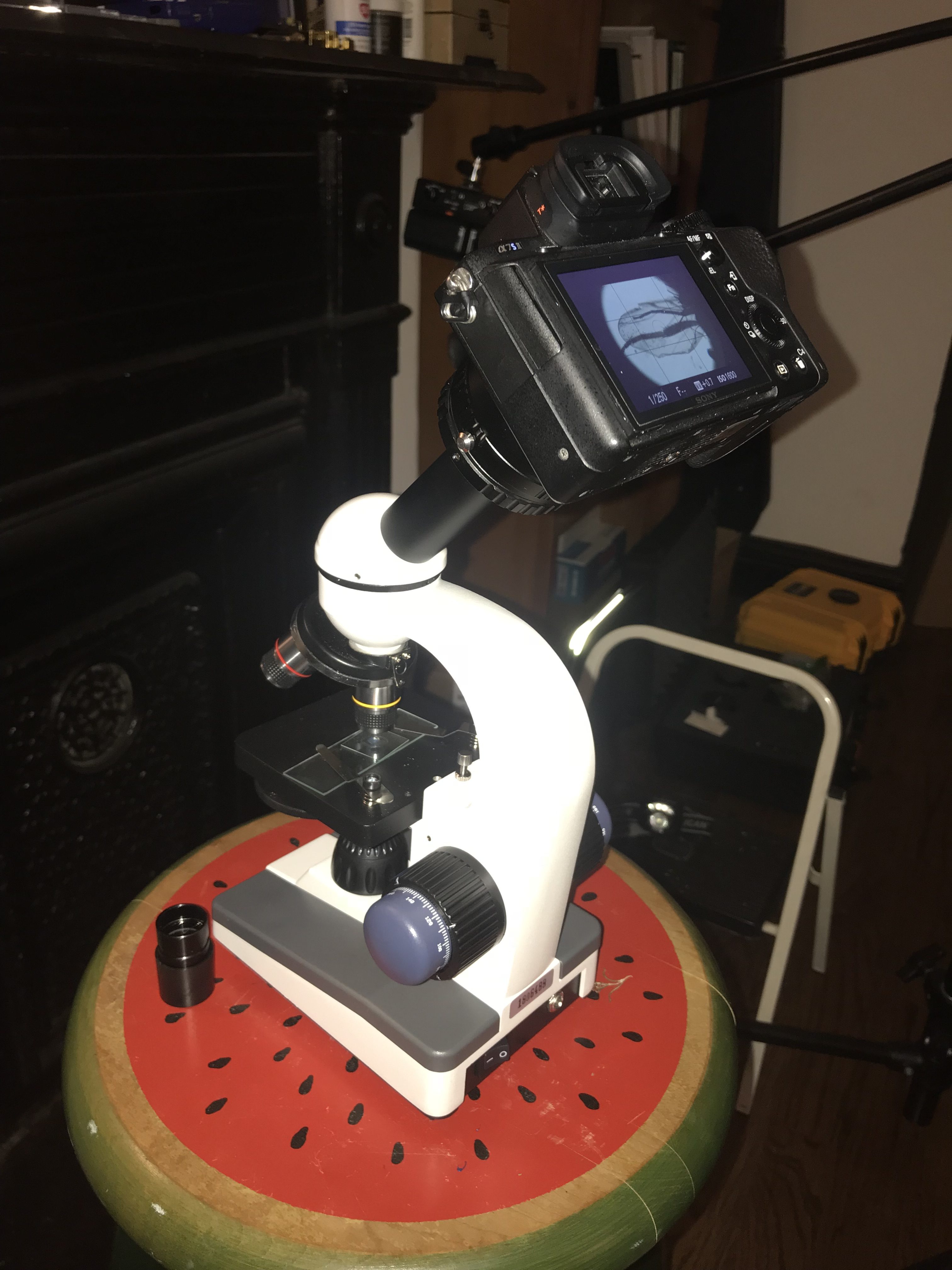
A7S mounted on a microscope
After the first few days of shooting I started to target my efforts more on small details of objects. I began focusing on textures and capturing incredibly close-up macro footage instead of larger scenes, which would have had more of a sense of space and environment. Not only did the limitations of the production lend themselves to shooting on a (literally) small scale, but I found that there was something thematically resonant about the idea of focusing in on the textures of objects as though they were the ingredients for each spell — combining physical materials that we would not typically associate with one another, but which, when abstracted through the lens, become part of a bizarre organic patchwork.
I shot a wide array of such materials using macro filters and zooming-in to the point where these objects were just barely recognizable: vegetables, wood, peeling paint, fabric, water droplets, house plants, fish, insects, fur, oil on a hot skillet, vinyl records, human skin, etc. I then took this idea one step further and figured out a way to mount the camera on a microscope and shoot materials at the molecular level: river water, cheek skin, a fruit fly, grains of salt, etc. Again, at this point, I had no idea what songs these images would be associated with or how they might fit together. I was just following my visual intuition/taste and a general thematic/aesthetic mindset with the faith that the structure of each piece and connections among the footage would become apparent at a later stage.
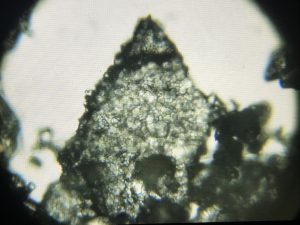
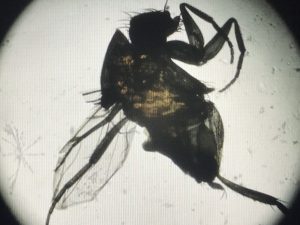
A grain of salt and a fly, under microscope
Given how forefronted Esperanza’s presence is in all of her music, I knew that we’d need her on camera for most if not all of the videos. However, we could not begin shooting her material until she had finished recording the record — we’d need the rough mixes for accurate playback on set. Additionally, her schedule was so packed due to the imminent release of the record that we could only get her for 1 day. Shooting Esperanza’s material for 12 different music videos in a single day meant that we would not have time to change locations, do any sort of meaningful production design work, or even moderately complex lighting; we would need to average about 1 hour of shooting per music video.
So I wanted a location that would have some built-in visual personality and a range of different looks. As it happened Esperanza was about to begin an artist residency with the beautiful Andrew Freedman Home in the Bronx. The AFH was initially built in the 1920s by NYC business magnate Andrew Freedman as a retirement home for formerly wealthy individuals who had lost their fortunes — i.e. an insurance policy on the dignity of your high social standing regardless of actual means. At some point in the mid-century it evolved into a more traditional retirement home and then around 2007 became an artist residency. So we reached out to the AFH about shooting our videos there and they were extremely receptive. I was able to tour the location and was struck by the third and fourth floors of the building, both awaiting renovation in the near future. The textures on every wall in every room were completely different and in various states of organic decay. It immediately felt visually akin to a lot of the macro/microscopic textures that I had been capturing. In addition to these un-renovated spaces, there was ample office space for us to set up a sort of black-box environment for the videos where I knew I’d want Esperanza set in more of a void.
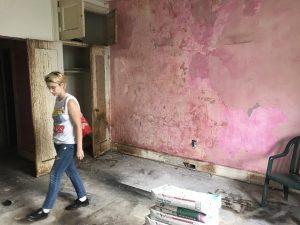
Andrew Freedman Home, exterior and interior
At this point I enlisted the help of my good friend and fellow Wesleyan alumnus Albert Tholen (‘15) for this marathon day of filming with Esperanza, along with my partner Julia and our makeup artist, Marcelo Gutierrez, who we were able to bring in for half the day. Esperanza had been in the studio for the past two weeks recording the record and the rough mixes were finally sent to me two days before our shoot. I took this time to sketch out some basic ideas for what locations in the building we’d use for each song and roughly how we’d approach shooting each one. I knew we’d only have time for two or three camera setups on each video, so I focused on creating simple compositions that felt distinct enough to differentiate the songs from one another and would allow Esperanza room to play and experiment with her performance as we shot. These two days of brainstorming were the closest I ever got to a sort of “treatment” phase for the videos – i.e. a pre-planned structure and shot list based on ideas inspired directly by the songs.
The shoot with Esperanza went wonderfully: she was incredibly flexible and gung-ho, fully down to jump into the rushed insanity of it all. And her presence as an on-camera performer was really something to behold. Every take of every performance was exciting, engaging, and really locked-in. We’d do a few takes of each setup, usually for sync issues, camera issues, or if we wanted to try a slightly different approach to her performance. But I always had the sense that if I was forced to use only the first take in the edit, I’d be fine. Our 12-hour schedule slowly stretched into a 16-hour day, but we were still somehow able to shoot Esperanza’s material for all twelve songs. By the last video of the day, which I believe was The Longing Deep Down, we had a total of thirty minutes for the whole thing! Again, none of this would have been possible without the incredible hustle and fantastic attitudes of Esperanza, Albert, and Julia.
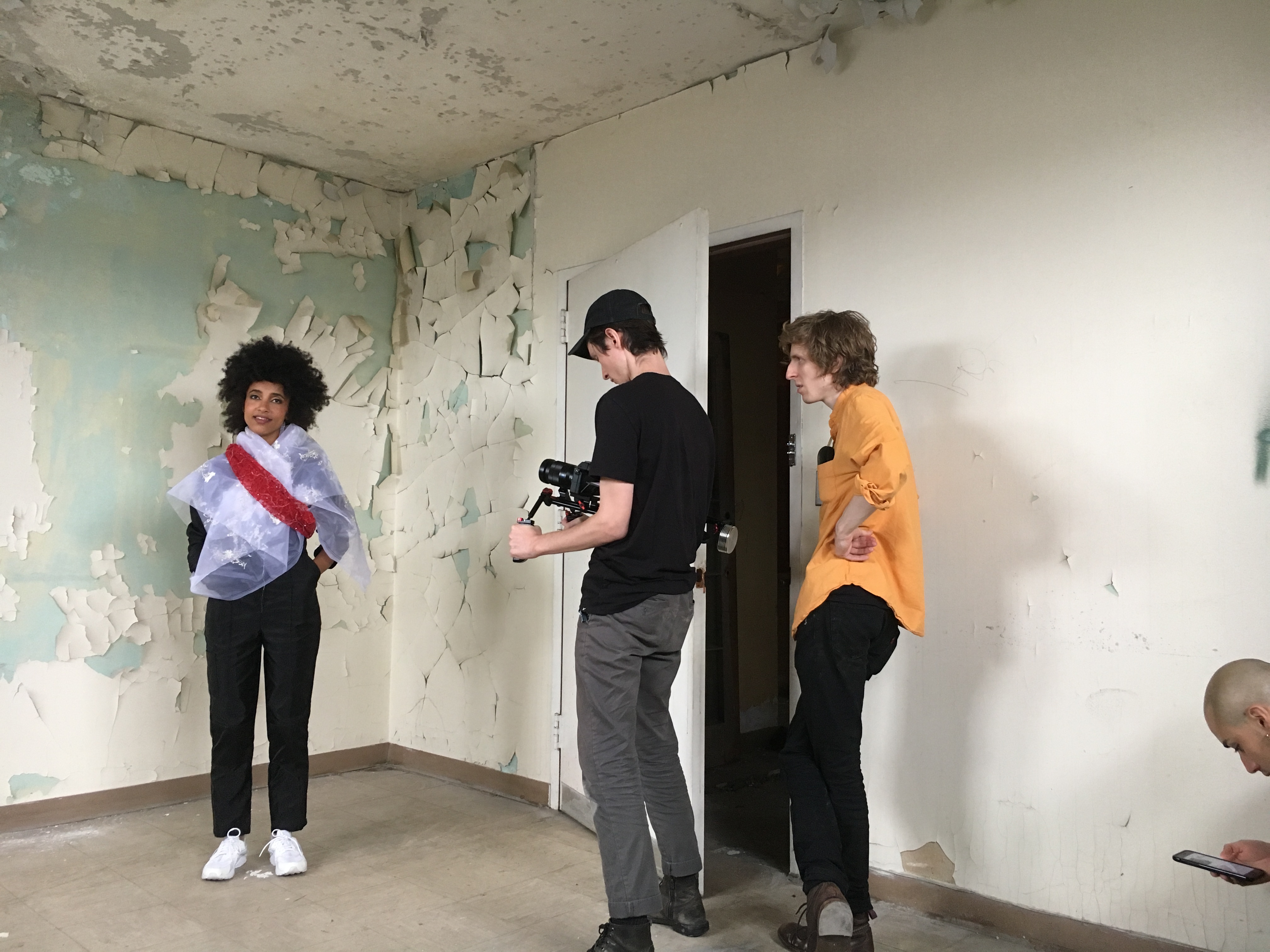
Esparanza, Albert, and Ethan
The very next day, Albert and I hopped straight into editing. The videos were set to release one-per-day for twelve days beginning on Oct 7th and we were about a week and a half out at that point. Our approach was to spend the first few days getting as much material into the timeline for each video as possible, so that we’d have at least a basic sense of which ones were in good shape and which ones were going to need some extra attention. For the majority of the videos, Albert would sketch out the structure and then pass his project over to me. I’d take it from an assembly or a rough cut to a final cut while he began working on the next video. This was the first time I’ve ever worked with another editor on one of my music videos, but I honestly don’t know how I could have done it otherwise. Even beyond the time constraints with this volume of material, it would have been so easy to lose perspective and get really off course trying to keep everything in my head at once. Having Albert next to me at all times allowed me to constantly check my work against his discerning eye. And the process of watching Albert’s cuts and giving notes forced me to think hard about what I wanted and to get specific enough that I could articulate that vision in clear, prescriptive terms.
We discovered the real idea of each video during this editorial process. In some cases, I had a notion going in of what non-Esperanza material I wanted to pair with what song (i.e. the macro footage of skin for Touch In Mine) or how I was going to visually structure a video (the mirrored dancing feet for You Just Have to Dance); but for the majority of the videos it was about stringing out the sections of Esperanza’s performance that we really loved and then experimenting with weaving in different non-Esperanza imagery, seeing what felt right, and then building a visual arc around that material. I had shot 70+ hours of footage (a lot of it was slow-motion) for this project, so we had a tremendous amount of material to pull from. The question was always about finding the imagery that felt as if it spoke to the tone of the song in some way, no matter how abstract.
For example, in The Longing Deep Down, the spell associated with the abdomen, I ended up using a lot of microscopic footage of the interior of a fruit fly. While filming this material, I shifted the focus on the microscope in and out rhythmically so that it pressed on the glass slide and made the interior of the fly look like it was pulsing. But taken totally out of its original context, this footage could look like endoscopic footage inside a person’s gut, moving between the organs as they expand and contract. I additionally cut in macro footage of oil bubbling on a hot pan and paint peeling on a wall, and before you knew it we had a full-fledged emotional inferno — all contained within the mid-section of a human body.
The process of getting notes from Esperanza was also incredibly smooth. Every once in a while I’d send her a batch of edits and get her thoughts. In one or two cases we did substantial changes based on her comments, but otherwise her notes consisted of little more than enthusiastic approval. And given how little runway time we had between the first cut of a given video and its release date, I’m not sure we could have made it work any other way. The final video for the album (With Others) was cut from concept to completion in 72 hours, with the finished version delivered only a few hours before its release. It remained a sprint to the last minute!
While this production process is not one I’m necessarily looking to repeat any time soon, I still feel that I learned a tremendous amount about the benefits of filmmaking under serious time constraints. In other projects I’ve had a tendency to let things drag out needlessly while I indulged little perfectionist whims to little noticeable effect. So this was certainly a therapeutic splash of cold water in the face and a reminder that sometimes going with your first impulse is better than ruminating on every choice for hours. As anyone who was living with me during this period can tell you, I did my fair share of squirming and hand-wringing and hair-pulling about whether any of this would work out or if I would simply lose steam and fail to deliver. But I’m proud of the results and of myself for having met this challenge.

